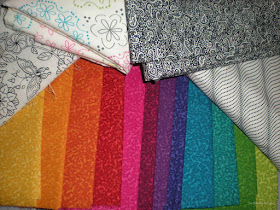Your top is pieced and you are ready to quilt it.
As with all things quilty there are different preferences for sandwiching your quilt top. I'm going to show how I sandwich my tops. I cut my backing and batting a few inches larger than the pieced top. I don't do the full four inches all around that long armers require, but that's because I quilt on my domestic machine.
I pin all my tops, lap size to wall hanging. I use masking tape, curved safety pins and the awesome Kwik Klip (no affiliation). I don't use spray baste. I know some swear by it. I don't because 1) I've never had success with it, my fabric always slides and shifts and I end up in tears and 2) I live in Minnesota, the only time I can use spray baste with proper ventilation is about 2 months out of 12. Really. It's either forty below or 80% humidity. (I say that with love, there is no better place for living the four seasons than Minnesota!)
When I quilt wall hangings, I piece my batting. I know it's not going to get washed so I just zig zag the pieces together.
Make sure you have nice straight edges, keep the seam in the middle and stitch. I use a 2.5 stitch length and 3.5 zig zag.
Lay out your backing, making sure it's nice and smooth. I'm showing a wall hanging, but I promise, I do this for the lap size as well, on my floor, which is going to end soon, because it's getting harder and harder to get up off the floor. Place piece of masking tape in the middle of one side, then making sure your backing is smooth and a little taut (no stretching) place another piece, exactly opposite,
on the other side.
Next, place a piece on either side of the middle tape, and across on the other side.
Then again, on the other side of the middle piece of tape, and again, across on the other side.
Repeat on the top and bottom.
Then smooth your batting over the backing and tape as you did the backing.
Lay your top over the layer and begin pinning from the center out. Pin every four inches or so. I just pin whatever looks right. Which, really means, I over pin. I'm a big believer in pinning. They are my favorite quilting tool for accuracy.
Don't miss any of the Beginners Unite! posts and make sure you come back for the August 2nd post for an exciting quilt along announcement! I'm moving the next Beginners post one day, because the August Muggamo pattern comes out on Tuesday.
Happy Stitching!
Jen
1) Intro - May 2
2a) Side Trip ~ Maintenance - May 11
3) Choosing fabric and color - May 16
4) Accurate cutting - May 23
5) That crazy scant 1/4 inch seam allowance - May 30
6) Sewing strips and squares - June 6
7) HST - Half Square Triangles (My one true love) - June 13
8) Flying Geese - June 20
9) What about those blocks that are just a tad off? - June 27
9) Strip Piecing - July 11
11) Is there a trick to keeping those points? - July 13
12) Adding borders - July 17
13) Sandwich that top - You are here
14) Quilting - August 2
15) Binding - August 8
16) Labels - August 15
16) Labels - August 15























































